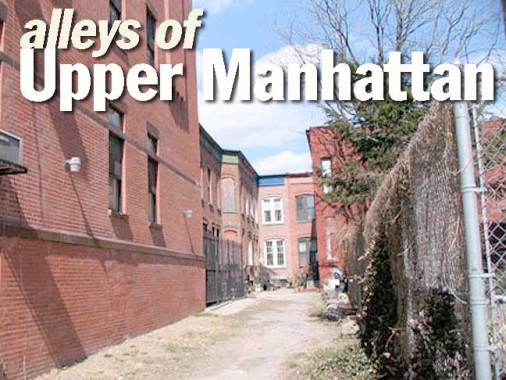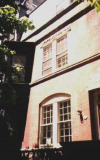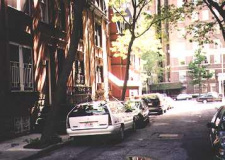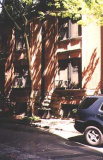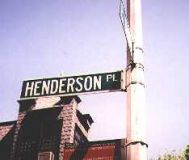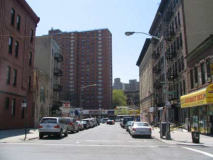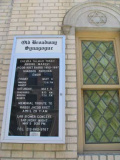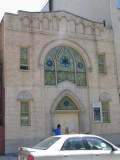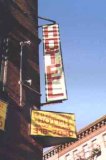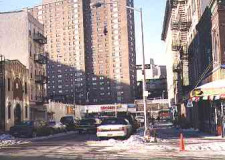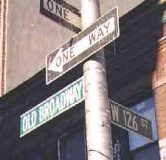North of Fourteenth Street, Manhattan is pretty uniform, with only Broadway and Central Park interrupting the gridiron of streets between 14th Street and 110th. Still, there are a few obscure dead ends to be found on the Upper East Side, Upper West Side and Washington Heights.
Henderson Place
Henderson Place has its very own Landmark District. A dead end north of 86th Street near East End Avenue just south of Gracie Mansion, is home to 24 row houses built in 1882 that are dwarfed by the high-rise apartment houses that are more typical of the area. It’s a world away from a heavily trafficked part of Manhattan near Schurz Park, and above it, Gracie Mansion. It is located in Yorkville, which was formerly the German-American capital of Manhattan.
Old Broadway
Old Broadway, or should we say, the “original” Broadway.
So why is there an Old Broadway in Manhattanville? Isn’t Broadway itself pretty old?
Very. It follows the path of a trail known in colonial days as Bloomingdale Road, which started at about where Madison Square is now, at 5th and 23rd (before these streets were mapped or cut through of course) continuing along the present path of Broadway to 86th Street, where it veered east, running between today’s Broadway and Amsterdam Aves. At 104th St it again assumed Broadway’s present route until 107th, where it turned NW until meeting the present path of Riverside Drive, following it to 116th. Here it turned northeast again, crossing Manhattan Street (today’s 125th Street) as Old Broadway. From 133 St it ran slightly east of the preent Broadway to Amsterdam and 144th Street (today’s Hamilton Place is a remnant) and ended at St. Nicholas Avenue and 147th Street.
What happened is that as Bloomingdale Road was straightened and widened into the Broadway we know and love today, a bend in the road between 125th Street and 133rd Street was left over…which became Old Broadway.
So, if you ever flop in the Old Broadway Hotel, know that you’re residing on an honest-to-God remnant of colonial New York.
The most significant structure on Old Broadway is the smallest one, Old Broadway Synagogue, incorporated in 1911. The present building dates to 1923. Amazingly, it is the only synagogue in Manhattanville or Harlem, to boot. Jewish populations held firm in Manhattanville decades after they had abandoned Harlem.
Vestiges of Harlem’s Jewish Past [NY Times]
In the 1960s, Old Broadway was separated into two pieces by the Manhattanville Houses.
Washington Terrace
At the opposite end of the spectrum from Henderson Place as far as urban cul-de-sacs go, Washington Terrace is off West 186th Street near Amsterdam Avenue in Washington Heights, just north of Yeshiva University. All of the row houses have seen better days and could stand a visit from Bob Vila. The roadway and sidewalks are rutted and crumbling.
Pomander Walk
Between W. 94 and W. 95 Sts. near Broadway, Pomander Walk is the only street in Manhattan named for a stage play. The alley and its row of small town houses were constructed in 1922 and have pretty much stayed unchanged since then.
In 1920, nightclub proprietor Thomas Healy acquired the property and hired the architectural firm King & Campbell, which designed a row of Tudor style buildings with various styles of brick, stucco and mock half-timbering.
“The effect obtained is as though a portion of the olden times was transported through the heart of the modern world.”–Architecture & Building Magazine, 1922.
Healy meant to tear down the buildings after a few years and construct a hotel, but this reminder of an earlier age is still there!
Some Pomander Walk residences preserve peculiarities from when they were first constructed, like exterior dumbwaiters. Some houses on Pomander Walk now sell for 2 and a quarter million. Photo above left: curbed
Chittenden Avenue
Chittenden Avenue, facing the waterfront between Alex Rose Place and 187th Streets, is named for a New Orleans merchant named Lucius Chittenden who owned the property bought by NYC in the 1840s.
At the edge of a cliff overlooking the Hudson River at Alex Rose Place and Chittenden Avenue is the Pumpkin House (the arrangement of its windows appears anthropomorphic when seen from the Henry Hudson Parkway or the river. As of March 2011, the place was for sale. The house, as do the others on Chittenden Avenue, has a fantastic view of the Hudson River.
Sylvan Court
Sylvan Court, a short dirt road on East 121st Street between Lexington and 3rd Avenues, is likely named for the condition of the surrounding area when the street was built: lots of trees.
If one is interested in seeing a quaint bit of Old Harlem it will be found just one block to the south and less than two blocks to the east from [Snake Hill]. As one walks through 121st from Lexington Avenue he will discern in the middle of the block a little street extending only to 120th street and known as Sylvan Place. A continuation of this ancient street to the north is designated by an iron arched sign as Sylvan Court. The court is really a blind alley, as it ends in the middle of the block, but there are several old-fashioned brick houses on both sides of the court and the entire atmosphere of the locality reminds one of some of the half-forgotten spots occasionally found in the Greenwich Village district. — New York Times, August 20, 1911
That description still holds true a century later!
Sources:
Christopher Gray, “A Tiny Street Where Interim Became Permanent”, New York Times, January 16, 2000
